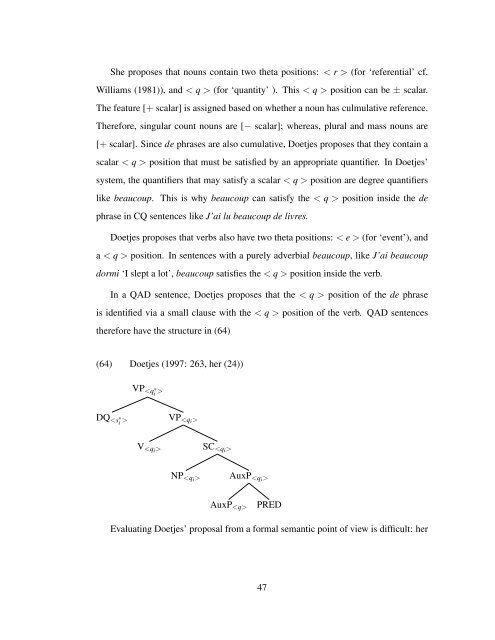Formal Approaches to Semantic Microvariation: Adverbial ...
Formal Approaches to Semantic Microvariation: Adverbial ...
Formal Approaches to Semantic Microvariation: Adverbial ...
Create successful ePaper yourself
Turn your PDF publications into a flip-book with our unique Google optimized e-Paper software.
She proposes that nouns contain two theta positions: < r > (for ‘referential’ cf.<br />
Williams (1981)), and < q > (for ‘quantity’ ). This < q > position can be ± scalar.<br />
The feature [+ scalar] is assigned based on whether a noun has culmulative reference.<br />
Therefore, singular count nouns are [− scalar]; whereas, plural and mass nouns are<br />
[+ scalar]. Since de phrases are also cumulative, Doetjes proposes that they contain a<br />
scalar < q > position that must be satisfied by an appropriate quantifier. In Doetjes’<br />
system, the quantifiers that may satisfy a scalar < q > position are degree quantifiers<br />
like beaucoup. This is why beaucoup can satisfy the < q > position inside the de<br />
phrase in CQ sentences like J’ai lu beaucoup de livres.<br />
Doetjes proposes that verbs also have two theta positions: < e > (for ‘event’), and<br />
a < q > position. In sentences with a purely adverbial beaucoup, like J’ai beaucoup<br />
dormi ‘I slept a lot’, beaucoup satisfies the < q > position inside the verb.<br />
In a QAD sentence, Doetjes proposes that the < q > position of the de phrase<br />
is identified via a small clause with the < q > position of the verb. QAD sentences<br />
therefore have the structure in (64)<br />
(64) Doetjes (1997: 263, her (24))<br />
VP <br />
DQ <br />
VP <br />
V <br />
SC <br />
NP <br />
AuxP <br />
AuxP <br />
PRED<br />
Evaluating Doetjes’ proposal from a formal semantic point of view is difficult: her<br />
47
















